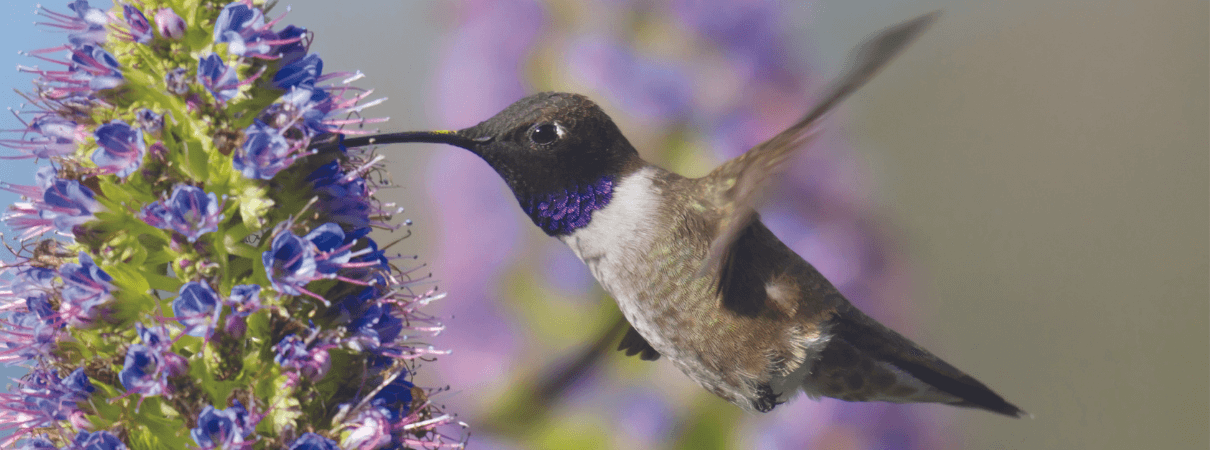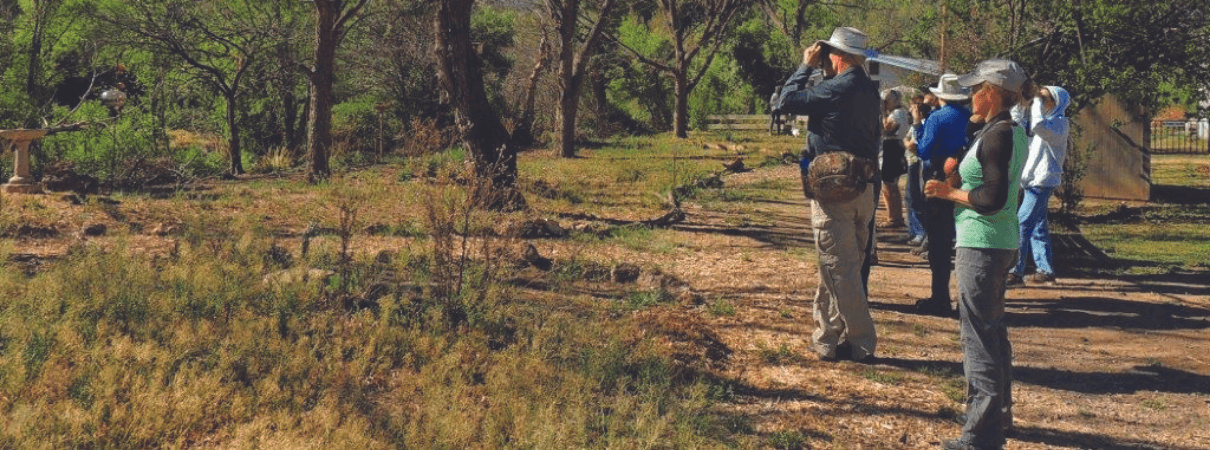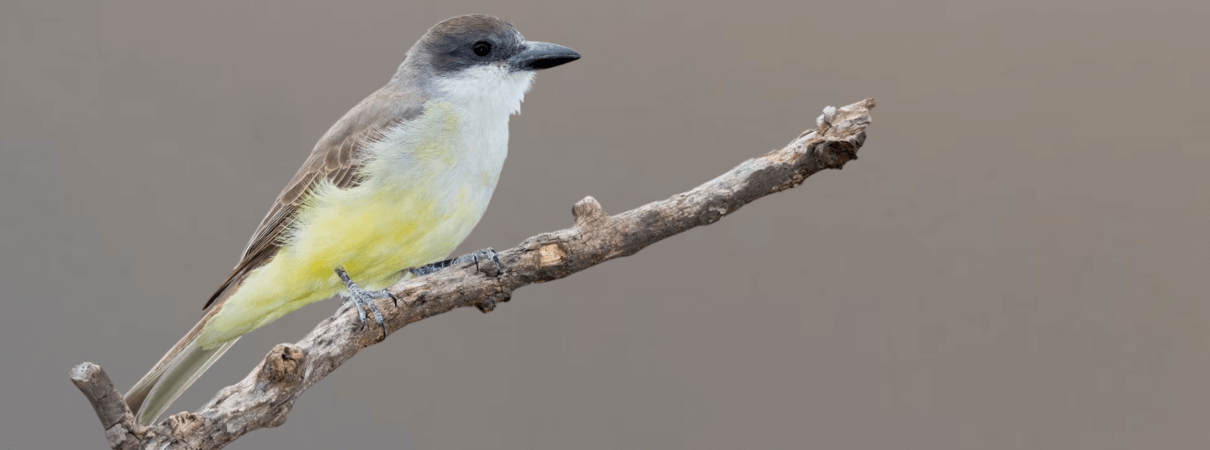ABC Birding: The Paton Center for Hummingbirds
"ABC Birding" is a triannual feature of Bird Conservation magazine that takes readers to birding sites benefiting from ABC and partners' conservation efforts. Some of these locations permit hunting and visitors are advised to review seasonal hunting dates and take necessary precautions before visiting. (Note, however, that there is no hunting at the Paton Center, below.) Travel may not be advisable for some at this time, and we suggest that readers review the CDC's coronavirus guidelines and local conditions before traveling.
Lay of the Land: The Paton Center for Hummingbirds (hereafter, the Paton Center) sits on 1.4 acres of riparian woodland fringing Sonoita Creek in the small southeastern Arizona town of Patagonia. The center is the former home of Wally and Marion Paton, who began inviting birders to visit their yard in 1973. Wally and Marion's became known as the place to see Violet-crowned Hummingbirds in the United States. Over the years, thousands of birders have stopped by to watch the feeders there. After Wally and Marion passed away in the early 2000s, ABC, the Tucson Audubon Society, and Victor Emanuel Nature Tours raised the funding needed to purchase the property, which the Tucson Audubon Society now manages as a haven both for birds and birders.

Violet-crowned Hummingbird. Photo by Matthew Studebaker.
Geographically, the Paton Center's location on Sonoita Creek places it in a riparian corridor that connects to the Santa Cruz River to the west and extends southward into the Mexican state of Sonora. In an otherwise dry landscape, this ribbon of woodlands is vital for wildlife. To the delight of U.S. birders, it also provides a path for species such as Violet-crowned Hummingbirds to move northward from Mexico.
There are several other famous birding locations along Sonoita Creek, including The Nature Conservancy's Patagonia-Sonoita Creek Preserve, the Patagonia Roadside Rest Stop, and Patagonia Lake State Park. Any or all of these can easily be included as part of a birding trip to the Paton Center.
Focal Birds: The Violet-crowned Hummingbird is the bird to see at the Paton Center. Native to western Mexico, this species' range just barely reaches into the United States, and the feeders at the Paton Center are the best — and often only — place in the country to see this spectacular bird. While the Violet-crowned may be the star of the show, an amazing total of 15 hummingbird species have been recorded at the Paton feeders, with 12 of these occurring most years. Depending on the time of year, Broad-billed, Anna's, Rufous, Broad-tailed, and Black-chinned Hummingbirds may all be present at the feeders, along with less-common species such as Costa's and Calliope Hummingbirds.

Black-chinned Hummingbird. Photo by sumikophoto, Shutterstock.
More than 210 bird species have been recorded on the Paton Center grounds, so if you can tear yourself away from the hummingbirds, watch for Gray Hawks, Thick-billed Kingbirds, Varied Buntings, Endangered “Western” Yellow-billed Cuckoos, and many other birds. In addition to the regular set of species, part of the excitement of birding in southeastern Arizona is the potential for vagrants. Over the years the Paton Center has hosted multiple rarities from Mexico, including a Cinnamon Hummingbird, a Crescent-chested Warbler, and several Plain-capped Starthroats and Rufous-backed Robins. Before visiting, be sure to check rare bird alerts to see what has been reported recently.
Other Wildlife: Sonoita Creek's lush woodlands are important for Bobcat, Gray Fox, and Javelina (also known as Collared Peccary). You may notice that the deer in the area seem a bit smaller than usual; southern Arizona is home to “Coue's” White-tailed Deer, a dwarf subspecies that averages about half the size of the White-tailed Deer found in the eastern United States. In between watching the hummingbird feeders, check the small pond on the center grounds to see the Gila Topminnow, an Endangered species found only in tributaries of the Gila River in Arizona and New Mexico.
When to Visit: Birding at the Paton Center can be spectacular at any time of year. In winter, temperatures are often in the 60s, and the resident birds are joined by large numbers of wintering sparrows and towhees. In the spring and fall, migrant warblers, tanagers, and buntings can be found. Summer temperatures rise to highs in the 90s, but bring breeding birds such as the Gray Hawk, Thick-billed Kingbird, and Varied Bunting. For hummingbirds, early spring is a good time to see the highest diversity of species, while late summer is the best time for overall numbers, with dozens of hummingbirds often present at the feeders in mid- to late August.

Visitors birding at the Paton Center. Photo courtesy of the Paton Center.
Conservation Activities: Since it acquired the property in 2014, the Tucson Audubon Society has been actively restoring native habitat around the Paton Center. The center's Richard Grand Memorial Meadow includes native plant species such as sage and Cardinal Flower that provide food for hummingbirds as well as an incredible 50 butterfly species.
Along Sonoita Creek, sacaton grass and Arizona Walnut trees have been planted to enhance this refuge's habitat for threatened and localized species. With the grounds now entirely planted with native species, the Paton Center serves as a showcase for native-plant gardening to the approximately 15,000 people who visit each year.
Directions: The town of Patagonia is a little over an hour's drive south of Tucson. Once you reach Patagonia, turn north off State Route 82 onto 4th Avenue (the turn is next to the Wagon Wheel Saloon). At the end of 4th Avenue, take a left onto Pennsylvania Avenue (there's a sign for the Paton Center at this T-junction). The Paton Center will be on your left in less than a quarter of a mile: Watch for the Violet-crowned Hummingbird sign. The center is open from dawn to dusk and though entry is free of charge, donations to the “sugar fund” help maintain the grounds and keep the hummingbird feeders well stocked.
In addition to visiting the feeders themselves, be sure to walk the brief loop trail in the “Paton Creekside Cuckoo Corridor” just across the road from the Paton Center. This area can be good for Thick-billed Kingbirds and Varied Buntings, as well as the namesake “Western” Yellow-billed Cuckoo. The entrance to the trail is on your right, just after Pennsylvania Avenue crosses Sonoita Creek.

Thick-billed Kingbird. Photo by Agami Photo Agency, Shutterstock.
Continuing southwest past the Paton Center, Blue Heaven Road borders The Nature Conservancy's Patagonia-Sonoita Creek Preserve, which provides fantastic opportunities to look for riparian birds. You can walk along the road from the Paton Center or park at one of the pullouts farther along. A pullout on the right 0.7 miles beyond the Paton Center marks the start of the Geoffrey Platts Trail, a 3.2-mile loop through drier habitat away from the creek. Then, 1.3 miles beyond the Paton Center, the entrance and visitor center for the Patagonia-Sonoita Creek Preserve is on the left (preserve open Wednesday to Sunday until 4 p.m.; $8 admission).
To visit the other birding sites around Patagonia, return to State Route 82. The Patagonia Roadside Rest Stop is a pullout on the south side of the highway 3.8 miles southwest of Patagonia. The rest stop looks unimpressive at first glance, but it has hosted incredible birds over the years, including a Fan-tailed Warbler, a couple of Yellow Grosbeaks, and nesting Rose-throated Becards. Another 3.4 miles south along State Route 82 from the Patagonia Roadside Rest Stop, a large sign marks the turnoff to Patagonia Lake State Park. The state park (open daily 4 a.m. to 10 p.m.; $15 for a day pass) can be good for waterbirds, including Neotropic Cormorants, Mexican Ducks, and, with luck, even the occasional Green Kingfisher. A birding loop trail at the east end of this park provides access to riparian habitat along the creek, as well as views over the lake itself. All told, more than 320 bird species have been recorded in Patagonia Lake State Park.
For more information, visit the Paton Center's webpage.
 | John C. Mittermeier is the Director of Threatened Species Outreach at ABC. He works with ABC's partners in Bolivia and helps to lead ABC's lost birds and bird trade initiatives. You can contact him via twitter @johnmittermeier. |


















































